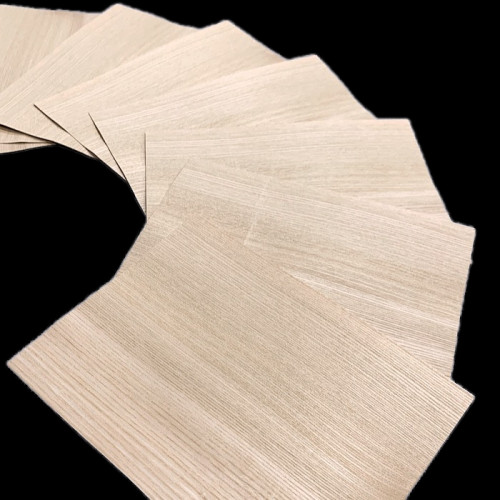
Japanese Elm Quarter-cut Small-size Veneers
Japanese Elm Quarter-cut Small-size Veneers
Genuine wood-sliced veneer sheets.
Fix length of 30 cm long.
Width: From 15 to 21 cm.
Thickness: 0.55 mm.
Sold by the sheet.
Japanese Elm Quarter-cut Small-size Veneers
Genuine wood sliced-veneer sheets.
Dimensions:
Fix length of 30 cm long.
Width: From 15 to 21 cm.
Thickness: 0.55 mm.
Sold by the sheet.
Measurement scaling:
Width rounded to the covered centimeter: 15.8, giving 15 cm.
Species:
Japanese elm, a remarkable semi-precious wood.
Common names
Japanese elm is also called sen, especially the sen haru variety, which is the variety used in craft and industry.
Botanical name
Ulmus davidiana var. japonica
Origin
Japanese elm is native to northeastern continental Asia and Japan, especially Hokkaido.
Structure
Japanese elm wood has a hollow structure, giving it a similar appearance to ash but with a finer flake, similar to the maple flake when the veneer is quarter-cut.
Color
Japanese elm has a blonde color, a bit like wheat fields.
Recognition
The pattern found between each hollow vein is the characteristic that allows you to recognize elm wood, whether from North America, Europe, or Asia.
This pattern is called "peacock feather" and recalls the colorful tail of the bird of the same name, but the more scientific name of this peculiarity is festoon parenchyma.
This pattern is most visible on crown-cut veneers and almost invisible on quarter-cut.
Physical and Mechanical properties
Japanese elm is a hardwood, light (about 620 kg per m3 kiln-dried) and torsion-resistant. However, it is not very resistant to abrasion, so it should be avoided for flooring.
Japanese elm is a wood that can be nervous and offer buckled veneers.
Traditional uses
Traditionally, Japanese elm has been used to manufacture furniture and taiko drums.
Contemporary uses
Today, Japanese elm is mainly used to manufacture high-end furniture and decoration, giving a clean and zen style.
Product Description:
Genuine wood-sliced veneer sheets.
These veneers are not in sequence and may come from different logs.
These veneers are raw without a finish or any fleece back.
The veneer surface is similar to plane wood. However, it will be preferable to forecast a light sanding after gluing.
The veneers are offered here as wood-sliced sheets of one and unique thickness.
Both faces of these veneers are the same, without fleece back or glue.
Even if the veneer's sides had been cut relatively straight, it isn't a precise parallel clipping; some veneers may have kept the decreasing shape of the tree, wider at the bottom end and narrower at the top end.
Very occasionally, some veneers' sides have traces of unclipped wane, but our veneers are measured at the narrowest, as explained in the paragraph "sizes."
As genuine natural wood, all finishing products are acceptable as long these products are meant to be used for wood.
The choice of the finished product must be consistent with the final usage realization.
Photos:
To keep the cost of these products as cheap as possible and contrary to other veneers on this website, the pictures of small-size veneers do not represent the available stock.
More information:
Please look at our TUTORIALS; you might find some valuable tips.
Please get in touch with us by email or phone for any additional information.
Data sheet
- Species
- Elm
- Thickness group
- Standard
- Width group
- Standard width
- Grade
- Quarter-cut
 English
English




